Solar energy
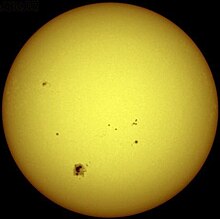
| Part of a series on |
| Renewable energy |
|---|
 |
Solar power (also known as solar energy) uses Solar Radiation emitted from our sun. Solar power, a renewable energy source, has been used in many traditional technologies for centuries, and is in widespread use where other power supplies are absent, such as in remote locations and in space.
Solar energy is currently used in a number of applications:
- Heat (hot water, building heat, cooking)
- Electricity generation (photovoltaics, heat engines)
- Transportation (solar car)
- Desalination of seawater
- Photosynthesis by plants
Energy from the Sun

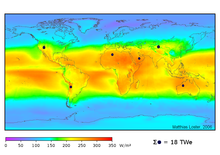
Solar radiation reaches the Earth's upper atmosphere at a rate of 1366 watts per square meter (W/m2).[1] The first map shows how the solar energy varies in different latitudes.
While traveling through the atmosphere, 6% of the incoming solar radiation (insolation) is reflected and 16% is absorbed resulting in a peak irradiance at the equator of 1,020 W/m².[2] Average atmospheric conditions (clouds, dust, pollutants) further reduce insolation by 20% through reflection and 3% through absorption.[3] Atmospheric conditions not only reduce the quantity of insolation reaching the Earth's surface but also affect the quality of insolation by diffusing incoming light and altering its spectrum.
The second map shows the average global irradiance calculated from satellite data collected from 1991 to 1993. For example, in North America the average insolation at ground level over an entire year (including nights and periods of cloudy weather) lies between 125 and 375 W/m² (3 to 9 kWh/m²/day).[4] This represents the available power, and not the delivered power. At present, photovoltaic panels typically convert about 15% of incident sunlight into electricity; therefore, a solar panel in the contiguous United States on average delivers 19 to 56 W/m² or 0.45 - 1.35 kWh/m²/day.[5]
The dark disks in the third map on the right are an example of the land areas that, if covered with 8% efficient solar panels, would produce slightly more energy in the form of electricity than the total world primary energy supply in 2003.[6] While average insolation and power offer insight into solar power's potential on a regional scale, locally relevant conditions are of primary importance to the potential of a specific site.
After passing through the Earth's atmosphere, most of the sun's energy is in the form of visible and infrared radiation. Plants use solar energy to create chemical energy through photosynthesis. Humans regularly use this energy burning wood or fossil fuels, or when simply eating the plants.
A recent concern is global dimming, an effect of pollution that is allowing less sunlight to reach the Earth's surface. It is intricately linked with pollution particles and global warming, and it is mostly of concern for issues of global climate change, but is also of concern to proponents of solar power because of the existing and potential future decreases in available solar energy. The order of magnitude is about 4% less solar energy available at sea level over the timeframe of 1961–90, mostly from increased reflection from clouds back into space.[7]
Types of technologies
Many types of technology have been developed to make use of solar radiation. Some of these technologies make direct use of the solar energy (e.g. to provide light, heat, etc.), while others produce electricity.
Solar design in architecture
Solar design in architecture involves the use of appropriate solar technologies to maintain a building’s environment at a comfortable temperature through the sun's daily and annual cycles. It may do this by storing solar energy as heat in the walls of a building, which then acts to heat the building at night. Another approach is to keep the interior cool during a hot day by designing in natural convection through the building’s interior.
Solar heating systems
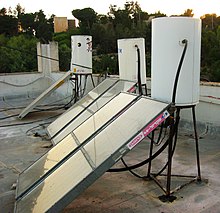
Solar hot water systems use sunlight to heat water. Solar hot water systems were used extensively in the United States up to the 1920s until replaced by relatively cheap and more reliable conventional heating fuels. The economic advantage of conventional heating fuels has varied over time resulting in periodic interest in solar hot water; however, solar hot water and heating technologies have yet to show the sustained momentum they lost in the 1920s. That being said, the recent spikes and erratic availability of conventional fuels has resulted in a renewed interest in solar heating technologies.
On a technical level, solar water heating is particularly appropriate for low temperature applications (100-150F). This advantage has been successfully applied to heating swimming pools where solar water heating can economically increase pool use. Solar water heating is also used in stand alone or hybrid domestic water heating systems.
Solar water heating systems are composed of solar thermal collectors, a storage tank and a circulation loop.[8] The three basic classifications of solar water heaters are:
- Batch systems which consist of a tank that is directly heated by sunlight. These are the oldest and simplest solar water heater designs, however; the exposed tank can be vulnerable to cooldown.[9]
- Active systems which use pumps to circulate water or a heat transfer fluid.
- Passive systems which circulate water or a heat transfer fluid by natural circulation. These are also called thermosiphon systems.
A Trombe wall is a passive solar heating and ventilation system consisting of an air channel sandwiched between a window and a sun-facing wall. Sunlight heats the air space during the day causing natural circulation through vents at the top and bottom of the wall and storing heat in the thermal mass. During the evening the Trombe wall radiates stored heat.[10]
A transpired collector is a perforated sun-facing wall. The wall absorbs sunlight and pre-heats air up 40F as it is drawn into the building's ventilation system. These systems are inexpensive and pay for themselves within 3-12 years in offset heating costs.[11]
Solar cooking

A solar box cooker traps the sun's energy in an insulated box; such boxes have been successfully used for cooking, pasteurization and fruit canning. Solar cooking is helping many developing countries, both reducing the demands for local firewood and maintaining a cleaner breathing environment for the community.
The first known western solar oven is attributed to Horace de Saussure in 1767, which impressed Sir John Herschel enough to build one for cooking meals on his astronomical expedition to the Cape of Good Hope in Africa in 1830.[12] Today, there are many different designs in use around the world.[13]
Solar lighting
Daylighting is a passive solar method of using natural light to provide illumination. Daylighting directly offsets energy use in electric lighting systems and indirectly offsets energy use through a reduction in cooling load.[14] Although difficult to quantify, the use of natural light also offers physiological and psychological benefits compared to conventional lighting.
Daylight features include building orientation, window orientation, exterior shading, sawtooth roofs, clerestory windows, light shelves, skylights and light tubes.[15] These features may be incorporated in existing structures but are most effective when integrated in a solar design package which accounts for factors such as glare, heat gain, heat loss and time-of-use. Architectural trends increasingly recognize daylighting as a cornerstone of sustainable design.
Hybrid solar lighting (HSL) is an active solar method of using natural light to provide illumination. Hybrid solar lighting systems collect sunlight using focusing mirrors that track the sun. The collected light is transmitted via optical fibers into a building's interior to supplement conventional lighting.[16]
Daylight saving time (DST) can be seen as a method of utilising solar energy by matching available sunlight to the hours of the day in which it is most useful. In 2001 this was estimated to reduce peak demand in California by 35–70 MW (0.08%–0.16%) in June through August, though total electricity use was unaffected.[17] However, there is some question whether these estimates are valid. In 2000 when parts of Australia began DST in late winter, overall electricity consumption did not decrease, but the peak load increased.[18]
Solar electricity
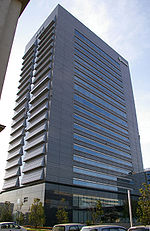

Solar cells, also referred to as photovoltaic cells, are devices or banks of devices that use the photovoltaic effect of semiconductors to generate electricity directly from sunlight. Until recently, their use has been limited because of high manufacturing costs. One cost effective use has been in very low-power devices such as calculators with LCDs. Another use has been in remote applications such as roadside emergency telephones, remote sensing, cathodic protection of pipe lines, and limited "off grid" home power applications. A third use has been in powering orbiting satellites and spacecraft.
To take advantage of the incoming electromagnetic radiation from the sun, solar panels can be attached to each house or building. The panels should be mounted perpendicular to the arc of the sun to maximize usefulness. The easiest way to use this electricity is by connecting the solar panels to a grid tie inverter. However, these solar panels may also be used to charge batteries or other energy storage device. Solar panels produce more power during summer months because they receive more sunlight. The cost payback time may take over 10 years depending on the cost of grid electricity and tax rebates.
Total peak power of installed PV is around 3,700 MW as of the end of 2005.[19] This is only one part of solar-generated electric power.
Declining manufacturing costs (dropping at 3 to 5% a year in recent years) are expanding the range of cost-effective uses. The average lowest retail cost of a large photovoltaic array declined from $7.50 to $4 per watt between 1990 and 2005.[20] With many jurisdictions now giving tax and rebate incentives, solar electric power can now pay for itself in five to ten years in many places. "Grid-connected" systems - those systems that use an inverter to connect to the utility grid instead of relying on batteries - now make up the largest part of the market.
In 2003, worldwide production of solar cells increased by 32%.[21] Between 2000 and 2004, the increase in worldwide solar energy capacity was an annualized 60%.[22] 2005 was expected to see large growth again, but shortages of refined silicon have been hampering production worldwide since late 2004.[23] Analysts have predicted similar supply problems for 2006 and 2007.[24]
Solar thermal electric power plants
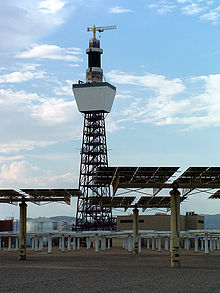
Solar thermal energy can be focused on a heat exchanger, and converted in a heat engine to produce electric power or applied to other industrial processes.
Power towers
The solar heat coming from the sun is reflected off the mirrors and is concentrated on the top of the tower where it will heat water or oil to boiling point. After the water or oil is heated it will be transferred to the power plant where it will make steam to turn a turbine to generate electricity.
Parabolic troughs
A long row of parabolic mirrors concentrates sunlight on a tube filled with a heat transfer fluid (usually oil). As with the power tower, this heated oil is used to power a conventional steam turbine, or stored for nighttime use. The largest operating solar power plant, as of 2007, is one of the SEGS parabolic trough systems in the Mojave Desert in California, USA (see Solar power plants in the Mojave Desert).
Concentrating collector with steam engine
Solar energy converted to heat in a concentrating collector can be used to boil water into steam (as is done in nuclear and coal power plants) to drive a steam engine or steam turbine. The concentrating collector can be a trough collector, parabolic collector, or power tower.
Concentrating collector with Stirling engine
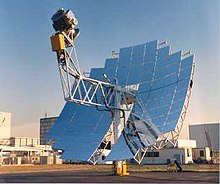
Solar energy converted to heat in a concentrating (dish or trough parabolic) collector can be used to drive a Stirling engine, a type of heat engine which uses a sealed working gas (i.e. a closed cycle) and does not require a water supply.
Until recently, a solar Stirling system held the efficiency record for converting solar energy into electricity (30% at 1,000 watts per square meter).[25] Such concentrating systems produce little or no power in overcast conditions and incorporate a solar tracker to point the device directly at the sun. That record has been broken by a high-performance crystalline silicon solar cell platform developed by a consortium led by the University of Delaware which has achieved a conversion efficiency of 42.8 percent.[26]
Solar updraft tower
A solar updraft tower (also known as a solar chimney, but this term is avoided by many proponents due to its association with fossil fuels) is a relatively low-tech solar thermal power plant where air passes under a very large agricultural glass house (between 2 and 8 km in diameter), is heated by the sun and channeled upwards towards a convection tower. It then rises naturally and is used to drive turbines, which generate electricity.
Energy tower
An energy tower is an alternative proposal to the solar updraft tower. It is driven by spraying water at the top of the tower, evaporation of water causes a downdraft by cooling the air thereby increasing its density, driving wind turbines at the bottom of the tower. It requires a hot arid climate and large quantities of water (seawater may be used) but does not require the large glass house of the solar updraft tower.
Solar pond
A solar pond is simply a pool of water which collects and stores solar energy. It contains layers of salt solutions with increasing concentration (and therefore density) to a certain depth, below which the solution has a uniform high salt concentration. It is a relatively low-tech, low-cost approach to harvesting solar energy. The principle is to fill a pond with 3 layers of water:
- A top layer with a low salt content.
- An intermediate insulating layer with a salt gradient, which sets up a density gradient that prevents heat exchange by natural convection in the water.
- A bottom layer with a high salt content which reaches a temperature approaching 90 degrees Celsius.
The layers have different densities due to their different salt content, and this prevents the development of convection currents which would otherwise transfer the heat to the surface and then to the air above. The heat trapped in the salty bottom layer can be used for heating of buildings, industrial processes, generating electricity or other purposes. One such system is in use at Bhuj, Gujarat, India[27] and another at the University of Texas El Paso.[28]
Solar chemical
Solar chemical is any process that harnesses solar energy by absorbing sunlight and using it to drive an endothermic or photoelectrochemical chemical reaction. Prototypes, but no large-scale systems, have been constructed.
One approach has been to use conventional solar thermal collectors to drive chemical dissociation reactions. Ammonia can be separated into nitrogen and hydrogen at high temperature and with the aid of a catalyst, stored indefinitely, then recombined later to release the heat stored. A prototype system was constructed at the Australian National University[29].
Another approach is to use focused sunlight to provide the energy needed to split water via photoelectrolysis into its constituent hydrogen and oxygen in the presence of a metallic catalyst such as zinc.[30]. Other research in this area has focused on semiconductors, and on the use of examined transition metal compounds, in particular titanium, niobium and tantalum oxides [31]. Unfortunately, these materials exhibit very low efficiencies, because they require ultraviolet light to drive the photoelectrolysis of water. Current materials also require an electrical voltage bias for the hydrogen and oxygen gas to evolve from the surface, another disadvantage. Current research is focusing on the development of materials capable of the same water splitting reaction using lower energy visible light.
Solar thermal energy also has the potential to be used directly to drive chemical processes that require significant amounts of process heat, including at high temperatures that can be otherwise quite hard to attain[32].
Solar desalination
This technique uses solar energy to evaporate sea water. The humid air is then condensed and desalinated water is collected.
Classifications of solar power technology
Solar power technologies can be classified in a number of ways.

Direct or Indirect
In general, direct solar power involves a single transformation of sunlight which results in a usable form of energy.
- Sunlight hits a photovoltaic cell creating electricity.
- Sunlight warms a thermal mass.
- Sunlight strikes a solar sail on a space craft and is converted directly into a force on the sail which causes motion of the craft.
- Sunlight strikes a light mill and causes the vanes to rotate as mechanical energy (little practical application has yet been found for this effect).
- In a direct solar water heater the water heated in the collector is used in the domestic water system.
In general, indirect solar power involves multiple transformations of sunlight which result in a usable form of energy.
- Vegetation uses photosynthesis to convert solar energy to chemical energy. The resulting biomass may be burned directly to produce heat and electricity or processed into ethanol, methane, hydrogen and other biofuels.
- Hydroelectric dams and wind turbines are powered by solar energy through its interaction with the Earth's atmosphere and the resulting weather phenomena.
- Ocean thermal energy production uses the thermal gradients present across ocean depths to generate power. These temperature differences are produced by sunlight.[33]
- Fossil fuels are ultimately derived from solar energy captured by vegetation in the geological past, but they would not normally be classed as solar energy.
Passive or active
This distinction is made in the context of building construction and building services engineering.
Passive solar systems use non-mechanical techniques of capturing, converting and distributing sunlight into usable outputs such as heating, lighting or ventilation. These techniques include selecting materials with favorable thermal properties, designing spaces that naturally circulate air and referencing the position of a building to the sun.
- Passive solar water heaters use a thermosiphon to circulate fluid.
- A Trombe wall circulates air by natural circulation and acts as a thermal mass which absorbs heat during the day and radiates heat at night.
- Clerestory windows, light shelves, skylights and light tubes can be used among other daylighting techniques to illuminate a building's interior.
- Passive solar water distillers may use capillary action to pump water.
Active solar systems use electrical and mechanical components such as photovoltaic panels, pumps and fans to process sunlight into usable outputs.
Concentrating or non-concentrating

Concentrating solar power (CSP) systems use lenses or mirrors and tracking systems to focus a large area of sunlight into a small beam capable of producing high temperatures and correspondingly high thermodynamic efficiencies. Concentrating solar is generally associated with solar thermal applications but concentrating photovoltaic (CPV) applications exist as well and these technologies also exhibit improved efficiencies. CSP systems require direct insolation to operate properly.[35]
Concentrating solar power systems vary in the way they track the sun and focus light.
- Line focus/Single-axis
- A solar trough consists of a linear parabolic reflector which concentrates light on a receiver positioned along the reflector's focal line. These systems use single-axis tracking to follow the sun. A working fluid (oil, water) flows through the receiver and is heated up to 400 °C before transferring its heat to a distillation or power generation system.[36][37] Trough systems are the most developed CSP technology. The Solar Electric Generating System (SEGS) plants in California and Plataforma Solar de Almería's SSPS-DCS plant in Spain are representatives of this technology.[38]
- Point focus/Dual-axis
- A power tower consists of an array of flat reflectors (heliostats) which concentrate light on a central receiver located on a tower. These systems use dual-axis tracking to follow the sun. A working fluid (air, water, molten salt) flows through the receiver where it is heated up to 1000 °C before transferring its heat to a power generation or energy storage system. Power towers are less advanced than trough systems but they offer higher efficiency and energy storage capability.[39] The Solar Two in Daggett, California and the Planta Solar 10 (PS10) in Sanlucar la Mayor, Spain are representatives of this technology.
- A parabolic dish or dish/engine system consists of a stand-alone parabolic reflector which concentrates light on a receiver positioned at the reflector's focal point. These systems use dual-axis tracking to follow the sun. A working fluid (hydrogen, helium, air, water) flows through the receiver where it is heated up to 1500 °C before transferring its heat to a sterling engine for power generation.[40][39] Parabolic dish systems display the highest solar-to-electric efficiency among CSP technologies and their modular nature offers scalability. The Stirling Energy Systems (SES) and Science Applications International Corporation (SAIC) dishes at UNLV and the Big Dish in Canberra, Australia are representatives of this technology.
Non-concentrating photovoltaic and solar thermal systems do not concentrate sunlight. While the maximum attainable temperatures (200 °C) and thermodynamic efficiencies are lower, these systems offer simplicity of design and have the ability to effectively utilize diffuse insolation.[39] Flat-plate thermal and photovoltaic panels are representatives of this technology.
Advantages and disadvantages of solar power

Advantages
- The 89 petawatts of sunlight reaching the earth's surface is plentiful compared to the 15 terawatts of average power consumed by humans.[41] Additionally, solar electric generation has the highest power density (global mean of 170 W/m2) among renewable energies.[41]
- Solar power is pollution free during use. Production end wastes and emissions are manageable using existing pollution controls. End-of-use recycling technologies are under development.[42]
- Facilities can operate with little maintenance or intervention after initial setup.
- Solar electric generation is economically competitive where grid connection or fuel transport is difficult, costly or impossible. Examples include satellites, island communities, remote locations and ocean vessels.
- When grid-connected, solar electric generation can displace the highest cost electricity during times of peak demand (in most climatic regions), can reduce grid loading, and can eliminate the need for local battery power for use in times of darkness and high local demand; such application is encouraged by net metering. Time-of-use net metering can be highly favorable to small photovoltaic systems.
- Grid-connected solar electricity can be used locally thus minimizing transmission/distribution losses (approximately 7.2%).[43]
- Once the initial capital cost of building a solar power plant has been spent, operating costs are low compared to existing power technologies.
Disadvantages
- Solar electricity can currently be more expensive than electricity generated by other sources.
- Solar heat and electricity are not available at night and may be unavailable due to weather conditions; therefore, a storage or complementary power system is required for most applications.
- Limited power density: Average daily insolation in the contiguous U.S. is 3-7 kW·h/m2[44][45][46] (see picture)
- Solar cells produce DC which must be converted to AC (using a grid tie inverter) when used in currently existing distribution grids. This incurs an energy loss of 4-12%.[47]
Availability of solar energy

There is no shortage of solar-derived energy on Earth. Indeed the storages and flows of energy on the planet are very large relative to human needs.
- The amount of solar energy intercepted by the Earth every minute is greater than the amount of energy the world uses in fossil fuels each year.[48]
- Tropical oceans absorb 560 trillion gigajoules (GJ) of solar energy each year, equivalent to 1,600 times the world’s annual energy use.[49]
- The energy in the winds that blow across the United States each year could produce more than 16 billion GJ of electricity—more than one and one-half times the electricity consumed in the United States in 2000.[50]
- Annual photosynthesis by the vegetation in the United States is 50 billion GJ, equivalent to nearly 60% of the nation’s annual fossil fuel use.[51]
Plants, on average, capture 0.1% of the solar energy reaching the Earth. The land area of the lower 48 United States intercepts 50 trillion GJ per year, equivalent to 500 times the nation’s annual energy use.[52] This energy is spread over 8 million square kilometers of land area, so that each square meter is exposed to 6.1 GJ per year. This results in potential biomass production of 6,100 GJ per square kilometer per year. Compared to the 0.1% efficiency of vegetation, roof installable amorphous silicon solar panels capture 8%-14% of the solar energy, while more expensive crystalline panels capture 14%-20%, and large scale desert mirror-concentrator heat engine based systems may capture up to 30-50%.
Energy storage
For a stand-alone system, some means must be employed to store the collected energy for use during hours of darkness or cloud cover. The following list includes both mature and immature techniques:
- Using traditional batteries
- Thermal mass
- Pumped-storage hydroelectricity
- Flow batteries
- Molten salt[53]
- Cryogenic liquid air or nitrogen
- Compressed air in cylinders and in caverns
- Flywheel energy storage
- Hydrogen produced by electrolysis
- Hydraulic accumulator
- Superconducting magnetic energy storages
- Vegetable oil economy
Storage always has an extra stage of energy conversion, with consequent energy losses, increasing the total capital costs. One way around this is to export excess power to the power grid, drawing it back when needed. This appears to use the power grid as a battery but in fact is relying on conventional energy production through the grid during the night. However, since the grid always has a positive outflow, the result is exactly the same.
Electric power costs are highly dependent on the consumption per time of day, since plants must be built for peak power (not average power). Expensive gas-fired "peaking generators" must be used when base capacity is insufficient. Fortunately for solar, solar capacity parallels energy demand; since much of the electricity is for removing heat produced by too much solar energy (using conditioners). This is less true in the winter when the peak energy use is in the early evening when food is being prepared and lighting, heating, and entertainment equipment loads are higher. Winter heating loads can be time shifted by storing thermal energy in bulk materials such as rock, water, or thermal phase transistion materials such as glauber's salt] or wax, provided solar ilumination is sufficient. Wind power complements solar power since it can produce energy when there is no sunlight but this advantage is highly dependant upon local and seasonal wind availability.
Deployment of solar power
"The Stone Age did not end for a lack of stones, and the oil age will end not for a lack of oil." — Sheik Yamani, Saudi oil minister, 1973
"We stopped using stone because bronze and iron were superior materials, and likewise we will stop using oil when other energy technologies provide superior benefits." — Bjørn Lomborg, The Skeptical Environmentalist (New York: Cambridge University Press, 2001), p. 120[54]
Deployment of solar power depends largely upon local conditions and requirements. All industrialised nations share a need for electricity and it is believed that solar power will increasingly be used as an option for electricity supply. The Very Large Scale Photovoltaic Power Generation (VLS-PV) proposal argues that "PV systems could generate many times the current primary global energy supply".[55] To compensate for night time energy demands they would need to be complemented with pumped storage.
Solar power by country
- See the articles for individual countries listed at Category:Solar power by country
Solar powered car

Development of a practical solar powered car has been an engineering goal for 20 years. The center of this development is the World Solar Challenge, a biannual solar powered car race over 3021 km (1877mi) through central Australia from Darwin to Adelaide. The race's stated objective is to promote research into solar-powered cars. Teams from universities and enterprises participate. In 1987 when it was founded, the winner's average speed was 67 km/h (42 mph).[56] By the 2005 race this had increased to an average speed of greater than 100 km/h (62 mph), even though the cars were faced with the 110 km/h (68 mph) South Australia speed limit.[57]
See also
References
- ^ "Solar Spectra: Standard Air Mass Zero". NREL Renewable Resource Data Center. 2006-10-17. Retrieved 2006-10-17.
{{cite web}}: Check date values in:|date=(help) - ^ Earth Radiation Budget "Earth Radiation Budget". NASA Langley Research Center. 2006-10-17. Retrieved 2006-10-17.
{{cite web}}: Check|url=value (help); Check date values in:|date=(help) - ^ Earth Radiation Budget
- ^ NREL: Dynamic Maps, GIS Data, and Analysis Tools - Solar Maps
- ^ "us_pv_annual_may2004.jpg". National Renewable Energy Laboratory, US. Retrieved 2006-09-04.
- ^ International Energy Agency - Homepage
- ^ Liepert, B. G. (2002-05-02). "Observed Reductions in Surface Solar Radiation in the United States and Worldwide from 1961 to 1990" (PDF). GEOPHYSICAL RESEARCH LETTERS, VOL. 29, NO. 10, 1421. Retrieved 2006-09-04.
- ^ NREL - Solar Hot Water
- ^ Solar Hot Water Heating History
- ^ EERE - Indirect Gain (Trombe Walls)
- ^ NREL - Transpired Air Collectors (Ventilation Preheating)
- ^ "Horace de Saussure and his Hot Boxes of the 1700s". Retrieved 2006-09-04.
- ^ "Solar Cooking Plans". Retrieved 2006-09-04.
- ^ IEA - Daylighting HVAC Interaction (pg 85)
- ^ DOE - Daylighting
- ^ ORNL - Solar Technologies Program
- ^ Adrienne Kandel; Daryl Metz (2001). "Effects of daylight saving time on California electricity use" (PDF). P400-01-013. California Energy Commission. Retrieved 2007-06-24.
{{cite journal}}: Cite journal requires|journal=(help)CS1 maint: multiple names: authors list (link) - ^ Ryan Kellogg; Hendrik Wolff (2007). "Does extending daylight saving time save energy? Evidence from an Australian experiment". CSEMWP 163. Center for the Study of Energy Markets. Retrieved 2007-05-16.
{{cite journal}}: Cite journal requires|journal=(help)CS1 maint: multiple names: authors list (link) - ^ Installed PV power
- ^ Regional Renewables.org Retrieved 28 November 2006
- ^ World Sales of Solar Cells Jump 32 PercentViviana Jiménez, 2004 Earth Policy Institute. Retrieved 4 September 2006.
- ^ Sun King Russell Flannery 27 March 2006. Retrieved 4 September 2006.
- ^ Silicon Shortage Stalls Solar John Gartner, Wired News, 28 March 2005. Retrieved 4 September 2006.
- ^ 2005 Solar Year-end Review & 2006 Solar Industry Forecast Jesse W. Pichel and Ming Yang, Research Analysts, Piper Jaffray, 11 January 2006. Retrieved 4 September 2006.
- ^ "Solar Stirling system ready for production". Retrieved 2006-09-06.
- ^ "New World Record Achieved in Solar Cell Technology" (Press release). U.S. Department of Energy. 2006-12-05. Retrieved 2006-12-06.
{{cite press release}}: Check date values in:|date=(help) - ^ Solar pond in Gujarat
- ^ Solar pond at University of Texas El Paso
- ^ K. Lovegrove, A. Luzzi, I. Soldiani and H. Kreetz "Developing Ammonia Based Thermochemical Energy Storage for Dish Power Plants." Solar Energy, 2003. http://engnet.anu.edu.au/DEresearch/solarthermal/pages/pubs/SolarEAmmonia4.pdf or http://dx.doi.org/10.1016/j.solener.2003.07.020
- ^ IsraCast: ZINC POWDER WILL DRIVE YOUR HYDROGEN CAR, Wired News: Sunlight to Fuel Hydrogen Future and Solar Technology Laboratory: SynMet
- ^ New Scientist issue 2577, 13 November 2006 Take a leaf out of nature's book to tap solar power by Duncan Graham-Rowe Accessed Nov 2006
- ^ J Murray. Investigation of Opportunities for High-Temperature Solar Energy in the Aluminum Industry, National Renewable Energy Laboratory report NREL/SR-550-39819 (USA).
- ^ NREL - Ocean Energy Basics
- ^ Les Fours solaires
- ^ DOE - Solar Basics
- ^ Plataforma Solar de Almería Concentrator Facilities
- ^ Sandia - Concentrating Solar Power Overview
- ^ Plataforma Solar de Almería - Linear-focusing Concentrator Facilities
- ^ a b c Quaschning, Volker (2003). "Technology Fundamentals: Solar thermal power plants" (Reprint). Renewable Energy World: 109–113. Retrieved 2006-12-7.
{{cite journal}}: Check date values in:|accessdate=(help); Cite has empty unknown parameters:|coauthors=and|quotes=(help); Unknown parameter|month=ignored (help) - ^ Sandia - Concentrating Solar Power Overview
- ^ a b Vaclav Smil - Energy at the Crossroads
- ^ Environmental Aspects of PV Power Systems
- ^ U.S. Climate Change Technology Program - Transmission and Distribution Technologies
- ^ NREL Map of Flat Plate Collector at Latitude Tilt Yearly Average Solar Radiation
- ^ http://www.eere.energy.gov/solar/cfm/faqs/third_level.cfm/name=Photovoltaics/cat=The%20Basics#Q43 DOE's Energy Efficiency and Renewable Energy Solar FAQ]
- ^ [1]
- ^ Renewable Resource Data Center - PV Correction Factors
- ^ accessdate=2006-12-12 "RRedC Energy Tidbits". NREL Renewable Resource Data Center. 2006-12-12.
{{cite web}}: Check|url=value (help); Check date values in:|date=(help); Missing pipe in:|url=(help) - ^ accessdate=2006-12-12 "RRedC Energy Tidbits". NREL Renewable Resource Data Center. 2006-12-12.
{{cite web}}: Check|url=value (help); Check date values in:|date=(help); Missing pipe in:|url=(help) - ^ accessdate=2006-12-12 "RRedC Energy Tidbits". NREL Renewable Resource Data Center. 2006-12-12.
{{cite web}}: Check|url=value (help); Check date values in:|date=(help); Missing pipe in:|url=(help) - ^ accessdate=2006-12-12 "RRedC Energy Tidbits". NREL Renewable Resource Data Center. 2006-12-12.
{{cite web}}: Check|url=value (help); Check date values in:|date=(help); Missing pipe in:|url=(help) - ^ accessdate=2006-12-12 "RRedC Energy Tidbits". NREL Renewable Resource Data Center. 2006-12-12.
{{cite web}}: Check|url=value (help); Check date values in:|date=(help); Missing pipe in:|url=(help) - ^ Solar Tres Project
- ^ Technology Roadmaps
- ^ Summary Energy from the Desert
- ^ History of World Solar Challenge The World Solar Challenge. Retrieved 4 September 2006.
- ^ Panasonic World Solar Challenge 21-28 October 2007 The World Solar Challenge. Retrieved 4 September 2006.
